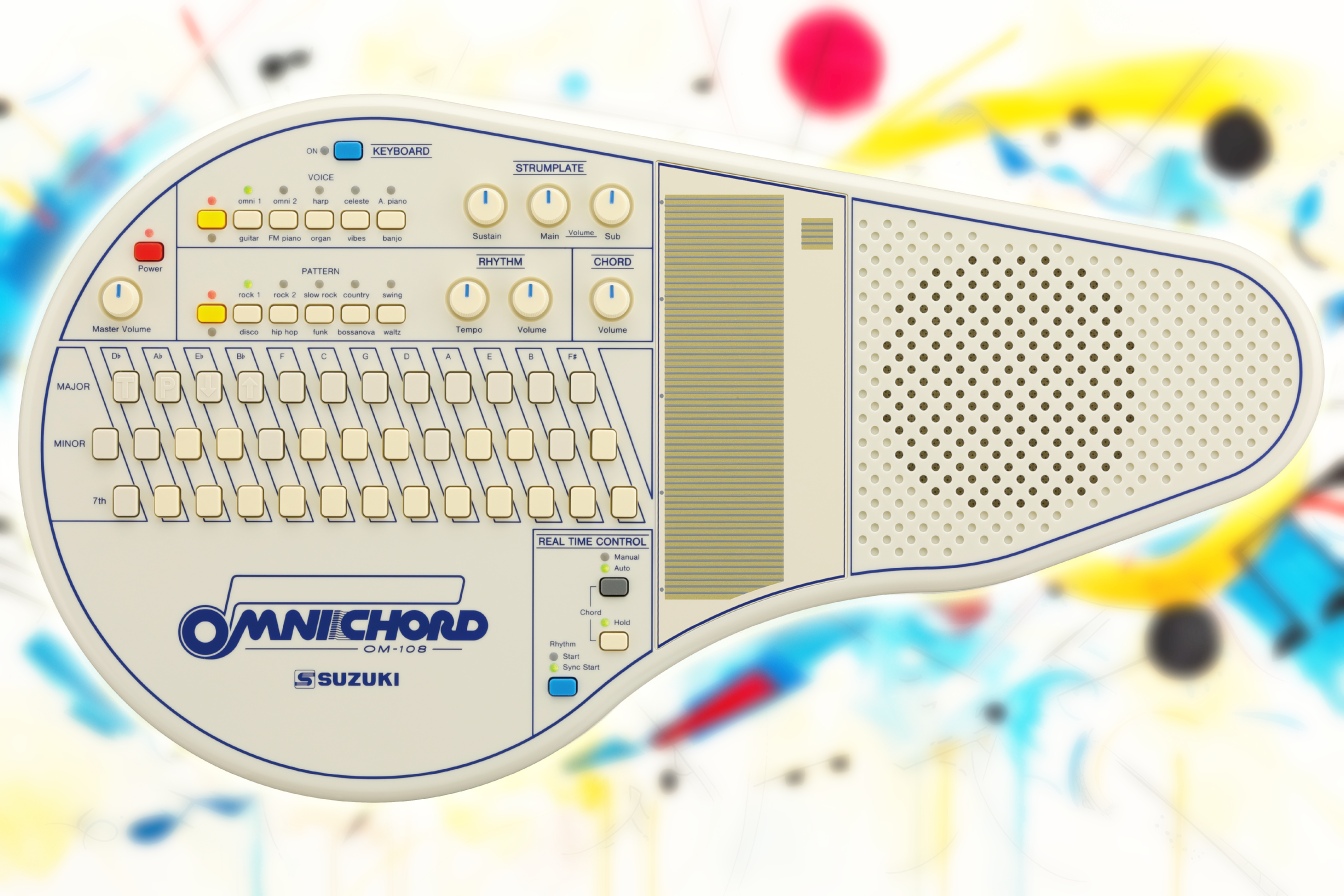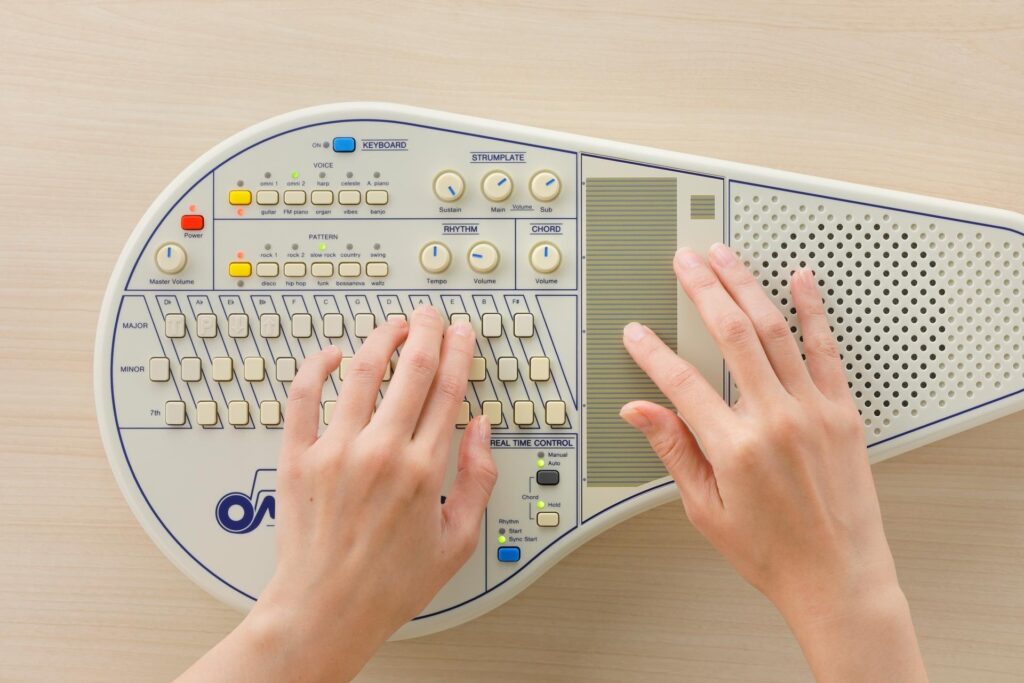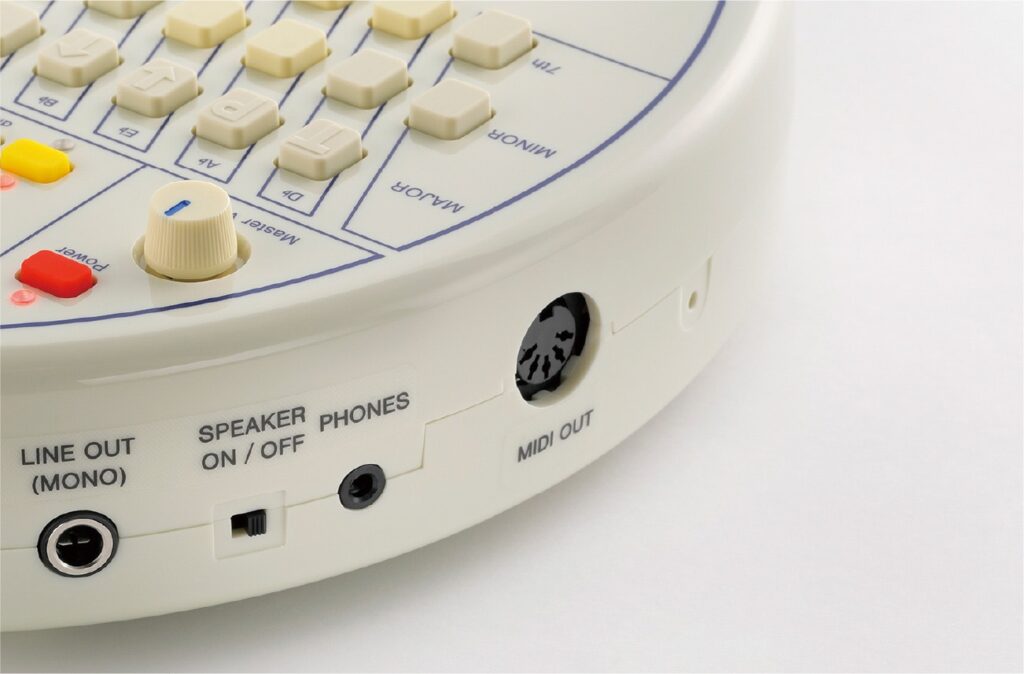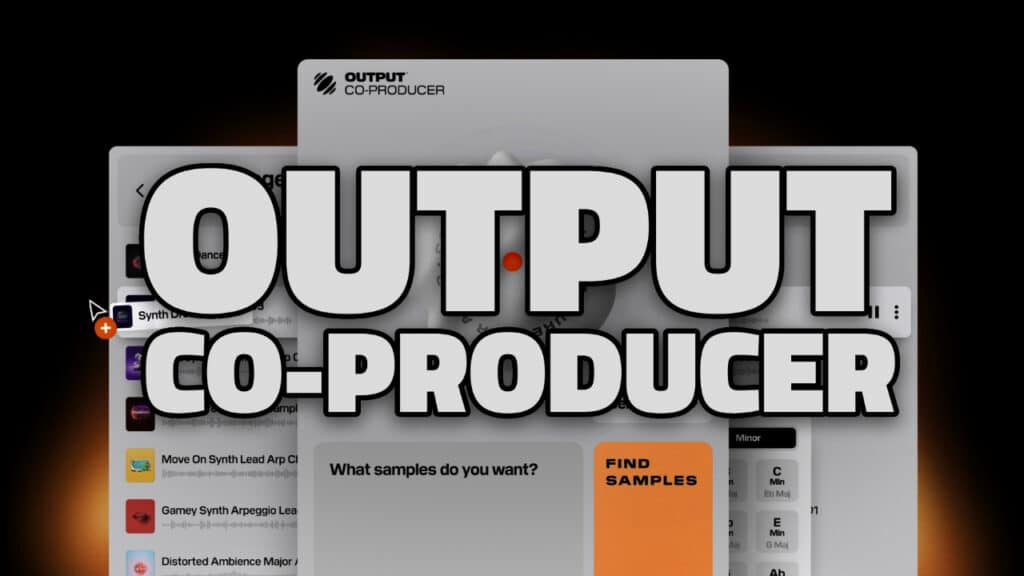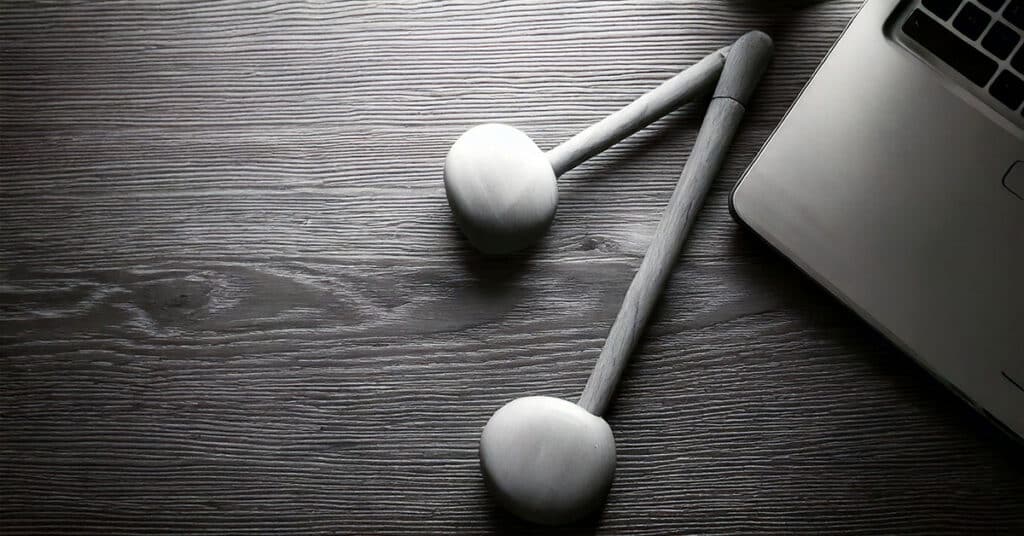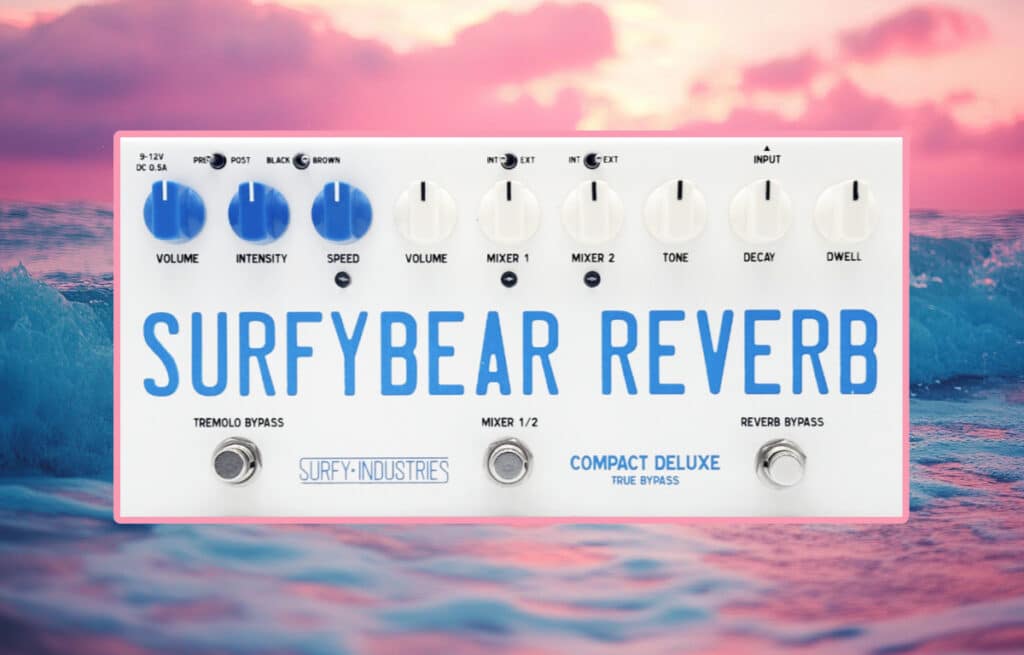At the recent NAMM show in Anaheim, Suzuki released the long-awaited Omnichord OM-108. Originally introduced in the early 80s, the Omnichord invigorated the electronic music world with its automatic accompaniment feature and innovative harp sensor, making music creation a possibility for even the most novice musicians. By simply pressing a chord button and gliding a finger across the sensor (referred to as the strumplate), users could effortlessly produce arpeggios corresponding to the chosen chord, facilitating easy song accompaniment without the need for prior musical training or familiarity with traditional notation. The Omnichord’s compact design made it a favorite musical companion, particularly in Europe and America, thanks to its portability. Its distinctive electronic tones reminiscent of the 1980s, combined with its tactile interface for musical expression, attracted a dedicated global following, achieving cult status. Before my review of the Omnichord OM-108, let’s have a look at the early days of the instrument.
SUZUKI OMNICHORD HISTORY
In 1980, Suzuki Corporation introduced two prototypes, namely the PC-27 Portachord and the Tronichord, preceding the debut of the OM-27 Omnichord in 1981. Named for its capacity to produce 27 different chords, the OM-27 swiftly gained popularity among singer-songwriters, particularly those seeking to generate chords without extensive theoretical knowledge or instrumental skills. Users select chords using buttons and strum them, eliminating the possibility of hitting “wrong notes.” By 1981, 40,000 units of the OM-27 had been shipped, primarily to the US and UK.
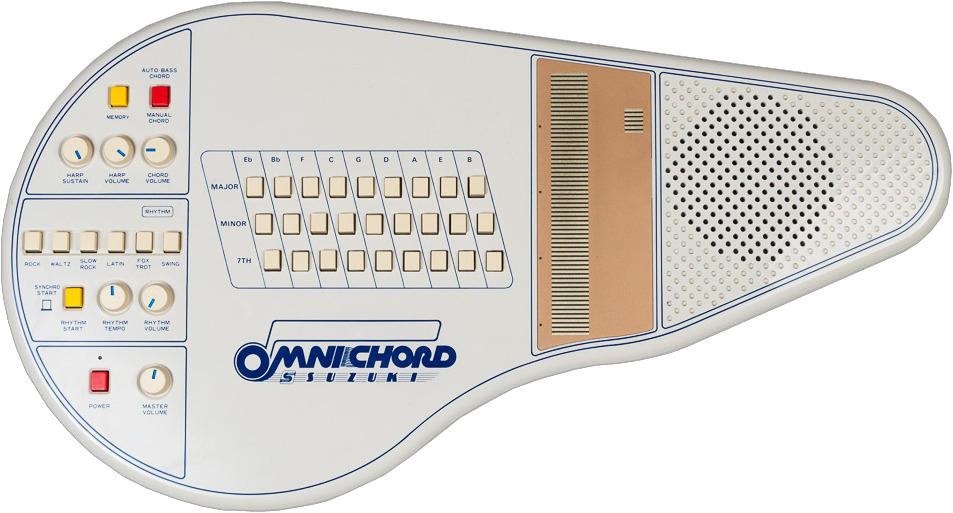
The OG Omnichord, an OM-27
The surge in demand led to design enhancements, resulting in the release of the OM-36 and OM-84 in subsequent years. The OM-84’s impressive 84-chord layout has persisted across nearly all models since, solidifying the Omnichord’s reputation beyond that of a mere novelty instrument. It found its way into the repertoire of musical acts such as Human League, David Bowie, and Brian Eno, the latter famously playing it while Pavarotti sang. Successive models included the OM-100, OM-200M, and OM-300, each generation incorporating new sounds and features, including MIDI compatibility.
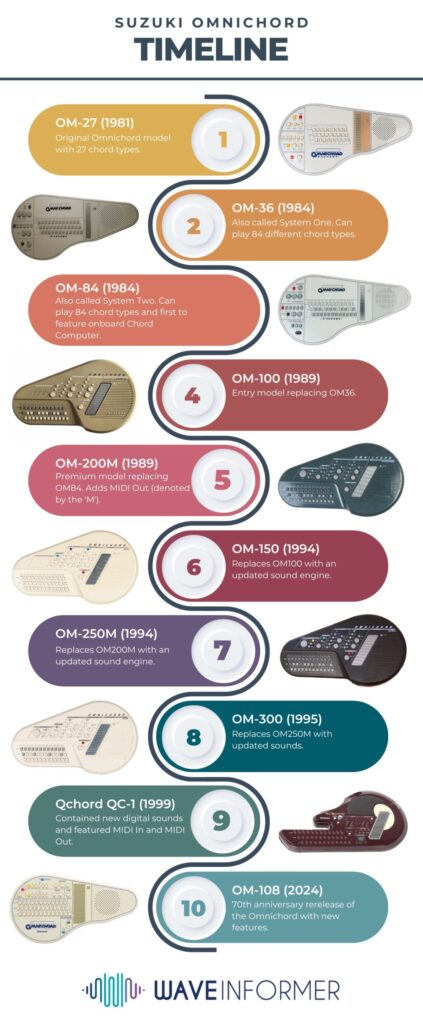
The lineage of the Omnichord
Sales began to decline by the 2000s, prompting Suzuki to rebrand the instrument as the QChord. This updated version retained the original Omnichord’s features while adding PCM sampled sounds, additional rhythms, and both MIDI input and output ports.
The Omnichord has enjoyed a cult following, still favored by musical artists like Gorillaz who used one to write their hit ‘Clint Eastwood’, and prominently featured in the Adventure Time song “Remember You” on Cartoon Network.
THE NEW OMNICHORD OM-108
As an owner of an original OM-100, I was thrilled to see the release of this beautiful instrument and was able to spend some quality time with the OM-108 at NAMM. Let’s look at how the latest iteration of this classic synthesizer stacks up. Make sure to subscribe for free to download the pack of drum loops I created using my Omnichord.
The Beautiful New Suzuki Omnichord OM-108, image courtesy of Suzuki
LOOKS AND LAYOUT
The Omnichord OM-108 looks and feels familiar. The construction is sturdy and aesthetically pleasing. From the elegantly printed Omnichord logo to the beautiful button colors reminiscent of the beloved OM-27. The widened strumplate, a thoughtful enhancement over previous models like the OM-100 and QC-1, effortlessly accommodates natural hand movements. Its sensitivity extends seamlessly to every edge, ensuring no missed notes, while the strategically placed instant-off touch plate prevents accidental interruptions.
The soft-touch rubber buttons, a hallmark of instruments from the OM-84 era onwards, are responsive and elegant. The reintroduction of rotary controls, though slightly narrower than those of the OM-84, offers convenient sound adjustments on the fly, positioned conveniently near the top of the strumplate.
Two additional chord buttons expand the chord palette from 84 to 108, introducing coveted Suspended 4th and Added 9th chords—long-requested features that promise new musical horizons. Not to be overlooked is the speaker grill reminiscent of the OM-27, designed to deliver exceptional bass response and rich sound quality.
Glancing at the rear left-hand side, reminiscent of the OM-84, we find an array of sockets thoughtfully positioned to avoid cable clutter during performances. Noteworthy is the monitor switch, ideal for those routing sound through external speakers while monitoring their own performance. Further enhancing versatility is the MIDI out port, a testament to Suzuki’s forward-thinking approach and commitment to future-proofing the OM-108 for evolving musical landscapes.
The flexible output section of the OM-108 makes it a versatile music-making companion for live and in-studio use
Underneath, the familiar raised rubber feet provide stability, while the expanded battery box now accommodates 8 x AA batteries, compatible with NiMH rechargeable batteries for eco-conscious musicians. A notable addition is the USB port, present in our sample for firmware updates, potentially enhancing the instrument’s functionality.
SOUND QUALITY
Utilizing analog circuitry, the OM-108 sounds exactly like you’d want an Omnichord to sound. Shimmering glissandos created by the strumplate, delightful lo-fi drum beats, and thick, warm chords produced by the accompaniment section.
RHYTHM
The pattern selection on the OM-108 contains the classics that made earlier iterations of Omnichords so useful. Patterns include:
- Rock 1, Rock 2, Slow Rock, Country, Swing, Disco, Hip Hop, Funk, Bossanova, Waltz
While retaining familiar names, the rhythms in the OM-108 have been refreshed to feature contemporary patterns. Notably, the inclusion of a trap beat (Hip Hop) marks a first for the Omnichord. The curated selection ensures that these “usable” rhythms cater to a broader range of musical styles, enhancing your playing experience with versatility.
The Omnichord OM-108 Pattern section, which includes 10 distinct beats
Navigating the rhythm unit is intuitive, with separate volume controls for drums and auto accompaniment (adjusting bass and chords together), alongside a versatile tempo control offering a wide range of speeds. Real-time control options abound, including Sync start for seamless rhythm triggering with chord changes, while the “HOLD” function ensures continuous playback even after releasing chord buttons—an ideal feature for sustained performances. The “MANUAL” mode toggles between vamping and the beloved Omnichord “drone,” perfect for solo play or creating rhythmic textures sans drums. Disabling “HOLD” enables staccato chord button play, adding dynamic versatility to your musical expression.
VOICES
The centerpiece of any Omnichord is the voices, and how those voices are controlled using the strumplate. Voices found on the Omnichord OM-108 include:
- omni 1, omni 2, hard, celeste, A. Piano, guitar, FM piano, organ, vibes, banjo
This range of classic instrument tones blend nostalgia with modern appeal. It retains favorites like the “celeste,” “harp,” and “piano” from earlier models, while introducing the new “FM piano” tone—a signature electric piano sound synonymous with 1980s music, similar to a Yamaha DX-7. With the inclusion of “omni1” and “omni2,” utilizing authentic analog circuitry, and PCM sound generation for other tones, the Omnichord OM-108 ensures a versatile musical experience that fans of the classic Omnichord will adore.
The 10 beautiful, sparkling voices of the Omnichord OM-108
The OM-108 now includes commonly used “sus4” and “add9” chords found in popular music. With these additions, the Omnichord boasts a total of 108 chord types, reflected in its model number. This evolution allows for more intuitive playing, eliminating the need to substitute chords and enhancing the instrument’s versatility.
NEW FEATURES
Pressing the “KEYBOARD” button transforms the chord buttons into a 20-key melody keyboard, with the option for octave shifting up and down. Additionally, users can layer tones for added depth and complexity. Note that when the “omin1” tone is chosen, the sound is monophonic, whereas other selections result in polyphonic sound.
Alongside the melody keyboard feature, the Omnichord OM-108 introduces drum pad mode for the first time, accessible when the “KEYBOARD” button is pressed. Users will appreciate that the drum pad is assigned to both the chord buttons and the strumplate, enabling the crafting of captivating beats with the retro drum kits included in the instrument.
OMNICHORD OM-108 SUMMARY
At the time of writing, the Omnichord OM-108 is set to be released later in 2024 with a price tag of $750. Admittedly, this substantial price could potentially deter first-time Omnichord buyers from acquiring this particular instrument. Nevertheless, the construction, sound quality, and new features are undeniably impressive.
For anyone that can’t swing the $750, which is completely understandable, I would personally recommend searching Facebook marketplace for a used Omnichord. I got my OM-100 for about $300 there. You should of course take necessary precautions, because… it’s Facebook, but I’ve seen prices cheaper than on Reverb.com.
The Omni 2 Plugin from Reverb Machine
For anyone who wants their Omnichord strictly in the box, check out the Omni 2 by Reverb Machine. Don’t forget to subscribe for free download the lo-fi Omnichord Drum Loops I created, and peep this video of me covering the theme from Succession on my Omnichord.

